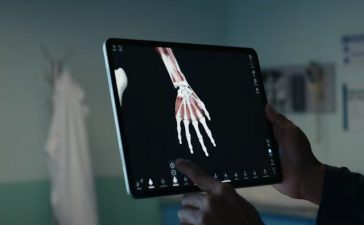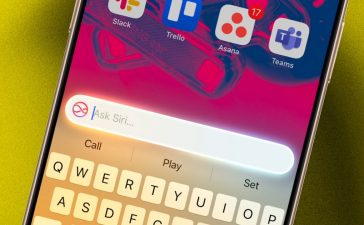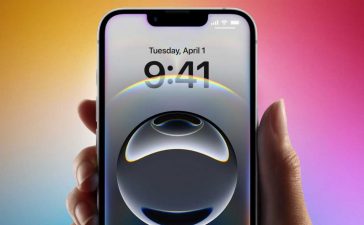At the launch of its Vision Pro headset in June, Apple offered up a variety of consumer entertainment uses, from watching front-row sports games to dodging 3D dinosaurs. But as the Pro branding suggests, Apple notably showed how the “spatial computing” device — the company’s marketing term for augmented and virtual reality — is also a natural fit for the workplace.
While other vendors, from Meta to Google and Magic Leap, have targeted the enterprise with AR and VR devices of their own, the overt focus on business was uncommon for Apple.
“The Vision Pro is unique in that Apple did talk about consumer use cases and entertainment, but they’re clearly focused on commercial use cases, in part because it’s such an expensive product,” said Tom Mainelli, group vice president for IDC’s device and research group.
Even if the hefty $3,500 price tag could hinder widespread adoption, the Vision Pro has the potential to be a productivity tool when it arrives in 2024.
“One of the main ways Apple is trying to position the Vision Pro as a headset for work is using it as an extension, or even a replacement, for your traditional desktop PC or laptop,” said Leo Gebbie, principal analyst at CCS Insight covering connected devices.
From an individual productivity perspective, Apple’s VisionOS provides access to multiple virtual screens that are accessible in augmented reality, with a user able to see their surroundings using the headset’s “pass through” function. As well as eye- and hand-tracking and voice recognition inputs, Apple’s wireless Magic Keyboard and touchpad can be used to interact with apps.
“The immediate use case is the idea that you could potentially have infinite display capabilities when working in your Mac,” said Mainelli. “That’s the least sexy use case for something like this, but I also think it’s probably the most realistic use case [in the short term].”
In addition to Apple’s own apps, including its Freeform brainstorming app, Keynote presentation tool and FaceTime for video meetings, users will also have access to productivity apps from Microsoft, such as Excel, Word and Teams, as well as Cisco and Zoom. A wider range collaboration and productivity apps will likely be available next year.
Mainelli said other workplace uses are likely to include collaboration, with the ability for designers to interact with 3D objects for instance, as well as employee onboarding and training; both are early enterprise use cases for VR.
What it’s less suited to is mobile use, even for remote assistance for frontline workers; that’s one area where augmented reality has already shown its value in the workplace. But the design of the Vision Pro — which is not exactly lightweight and requires a tethered battery back for around two hours of on-the-go power — and its focus on immersive virtual reality means deskless workers won’t find the device as useful.
“It’s really more of a stationary-type product, not something that you would take in the field,” said Mainelli.

The Vision Pro only lasts two hours on battery, making it more suitable for non-mobile use.
Gennie agreed: “It felt as though this was primarily targeted at desk-based workers, rather than other more interactive enterprise use cases.”
Apple’s Vision Pro: fit for work?
Despite major investments from tech bigwigs such as Apple and Meta in developing virtual and augmented reality, creating hardware that’s comfortable, easy to use and reasonably priced has proved elusive. (The initial feedback from those who actually demoed the Vision Pro indicates Apple at least partially addressed some of these concerns, though price remains an issue.)
The relatively high cost — it’s still less than some “professional-grade” headsets from the likes of Varjo and HTC — is reflected in Apple’s choice of higher-end components designed to provide a better user experience than cheaper alternatives. For instance, the high-resolution OLED screens, supposedly akin to a 4K display for each eye, make reading text in apps much easier.
“Those OLED screens are a big part of the reason why it’s so expensive,” said Mainelli. “The challenge with less expensive virtual reality headsets is that fidelity is not high enough to be able to work in that setting for any length of time, certainly not for hours,” he said.
Delivering a relatively frictionless user experience is also important to user productivity — another area where rival vendors have struggled.
“Apple will bring its strength to this area in the fluidity and ease of use of the ecosystem of Apple devices and software,” said Gebbie. “That suddenly makes it significantly easier for workers to think about elements of their workflow that they might want to move into spatial computing. It’s a real strength that Apple has in this segment, where I think rivals like Meta have struggled to engineer that sort of thing so far.”
Initial demand likely to be low
Despite generally upbeat assessment from those who’ve been able to try out the Vision Pro, it’s unlikely to drive significant businesses adoption upon launch. Apple itself is believed to anticipate relatively limited sales (at least, compared to sales of Macs, iPads and iPhones); Bloomberg reported in May anticipated sales of around 900,000 units in 2024, due in part to production constraints, and, of course, the price tag.
“This isn’t something that is likely to replace people’s laptops just yet,” said Gebbie. And business deployment of headsets like the Vision Pro to any significant degree is “years away,” he said.
“Right now, if you are equipping a desk-based worker to collaborate with colleagues, you typically just need to give them a laptop. It has the screen, keyboard, webcam, you can join Teams, Zoom, all these applications, and deploying your laptop costs relatively little money.
“The Vision Pro costs three and a half thousand dollars and it will take time for people to learn a new set of behaviors and understand how to get the most out of the device.”
Some “forward-thinking” businesses might want to purchase the Vision Pro upon launch, but in fairly small numbers, Mainelli said. And that assumes they’re even able to get their hands on devices.
“I don’t imagine we’ll see big deployments. In fact, I don’t think we’ll see huge numbers of shipments in the first year. But people will start playing around with it and figuring out how they can best leverage it,” said Mainelli.
Gebbie agreed that many businesses will want to at least try out the Vision Pro. “There’ll be a lot of businesses out there that will probably get a unit or two and test different uses, to try and work out where the strengths andweaknesses are,” he said.
Apple’s future plans for AR
The Vision Pro is likely just an early stage in Apple’s long-term strategy around virtual and – more importantly – augmented reality; the immediate goal is to generate interest and spur developers to conjure up apps that attract a larger audience. Rumors are already circulating about the next iteration, with a cheaper device thought to be under development.
Producing a device with a price tag more suitable for widespread adoption remains a significant challenge, and the high cost of VR/AR headset components means businesses shouldn’t expect Apple to deliver a similarly powered headset at a significantly lower price anytime soon, said Mainelli.
“I think that will be harder than people realize,” he said. “The reason it’s so expensive is because of all the technology that goes into [a headset]: You can’t just take out cameras and sensors, because then you can change the experience,” he said.
With the Vision Pro set to launch in the first quarter of 2024, assuming no production delays, a more mainstream version could be a year to two away. “And even that device may not be something that you would expect to ship in the kind of volumes that you see from a product like the Apple Watch.
“I would say this is a decade-long journey that Apple’s on: the Vision Pro is just the first step.”
Apple is clearly moving forward. According to The Verge, it recently acquired Mira, a startup that sells AR headsets and software aimed at remote assistance for industrial workers. Mira’s device relies on an iPhone to power the headset’s interface.
It remains unclear what the acquisition, one of several AR startups Apple has bought in recent years, will mean for the company’s long-term strategy. It could incorporate Mira’s technology into its own products, or, more likely, use the purchase to add to its expertise and intellectual property.
It can also be seen as another indication of Apple’s long-term plan: smartglasses that are no more obtrusive than regular eyeglass frames. Those would benefit businesses as much as consumers.
“The acquisition of Mira shows that Apple is clearly still focused on augmented reality as the end goal here, in terms of a device that doesn’t block you off from the external world in the same way the Vision Pro does. It’s still fundamentally a headset that closes you off from the world somewhat,” said Gebbie.
“In terms of Apple’s future product roadmap, there is very little doubt in my mind that the eventual end goal for this play in spatial computing is to reach the point where the company could launch augmented reality smartglasses. Smartglasses are the nirvana for lots of people in this space.”
Copyright © 2023 IDG Communications, Inc.












